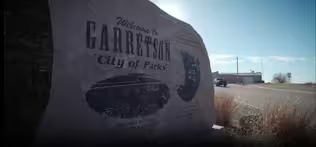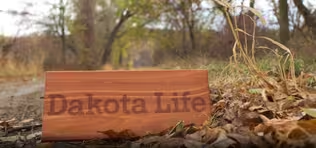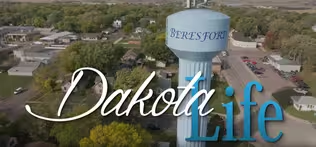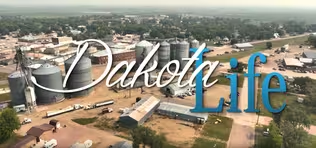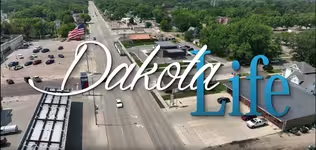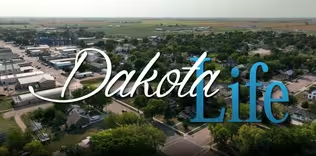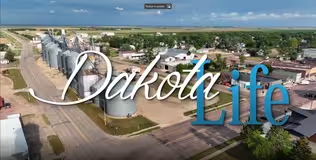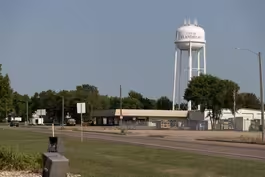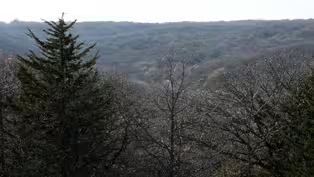Dakota Life
Greetings from the Corn Palace
Season 23 Episode 7 | 26m 16sVideo has Closed Captions
Greetings from the Corn Palace plus stories from southeast South Dakota and Aberdeen.
Ruskin Park is an old music hall near Forestberg, nothing exists now but memories. Dakota Valley junior August Schenzel shows his passion for sport as football and basketball student manager. Follow a University of Sioux Falls literature professor on a class field trip. Visit Storybook land in Aberdeen and celebrate Leo Weber. And check in with Matthew Mors of Yankton Bucks Basketball.
Problems playing video? | Closed Captioning Feedback
Problems playing video? | Closed Captioning Feedback
Dakota Life is a local public television program presented by SDPB
Support Dakota Life with a gift to the Friends of Public Broadcasting
Dakota Life
Greetings from the Corn Palace
Season 23 Episode 7 | 26m 16sVideo has Closed Captions
Ruskin Park is an old music hall near Forestberg, nothing exists now but memories. Dakota Valley junior August Schenzel shows his passion for sport as football and basketball student manager. Follow a University of Sioux Falls literature professor on a class field trip. Visit Storybook land in Aberdeen and celebrate Leo Weber. And check in with Matthew Mors of Yankton Bucks Basketball.
Problems playing video? | Closed Captioning Feedback
How to Watch Dakota Life
Dakota Life is available to stream on pbs.org and the free PBS App, available on iPhone, Apple TV, Android TV, Android smartphones, Amazon Fire TV, Amazon Fire Tablet, Roku, Samsung Smart TV, and Vizio.
Providing Support for PBS.org
Learn Moreabout PBS online sponsorshipMore from This Collection
Dakota Life stories from towns in southeast South Dakota
Greetings from Wessington Springs
Video has Closed Captions
Most cities shape the landscape they’re on, but in Wessington Springs it’s the other way around. (29m 45s)
Video has Closed Captions
Discover the beauty and history of Palisades State Park, goat yoga, and a very special love story. (29m 46s)
Video has Closed Captions
Beresford hosts the Frostbite 4, a regional favorite winter road race. (26m 26s)
Video has Closed Captions
From a window to the past to raising the next generation, Dakota Life explores Wagner. (28m 53s)
Video has Closed Captions
Greetings from Madison, the center of Lake County. (28m 55s)
Video has Closed Captions
Dakota Life showcases Newton Hills and the SD State Park system. (28m 5s)
Providing Support for PBS.org
Learn Moreabout PBS online sponsorship(bright music) - [Larry] Mitchell is surrounded by farms and fields and celebrates agriculture in a very unique way.
Early residents promoted the community, hoping to recruit immigrant farmers and some of the first farmers put up their harvest, literally, as a decoration on the first Corn Palace in 1892.
And it worked!
Farm life and Mitchell culture have been truly integrated.
Welcome to Dakota Life from The World's Only Corn Palace.
It's our home base as we bring you stories from other parts of the state too.
This structure is the third rendition of the Corn Palace.
It opened 100 years ago in 1921.
The Corn Palace is more than the domes and the murals on the outside.
There's the Corn Palace Festival and a lot of other entertainment inside along with folk art and community history.
There's another entertainment, just 20 miles north of here.
For most of the '50s and '60s, Ruskin Park thrived on the shores of the James River near Forestburg.
It's gone now, but it's not forgotten.
- [Narrator] After Ruskin Park opened as a Chautauqua-style entertainment venue in 1902, it became so popular that it had its own railroad spur.
- They didn't have a permanent pavilion.
They had a big tent and I heard that it would seat up to 1,500 people in this huge tent.
And they built a two-story hotel, and then, over the years, they built, like in the first 10 years, I think, they had a horse racing track there.
Then, they added a car racing track.
They had a ball field.
Later on, they had a golf course, and then of course, you know, with it being on the Jim River, it had a lot of events on the Jim River, like canoeing and swimming and fishing and all kinds of things like that.
- [Narrator] The Chautauqua movement that began out east in the 1870s lasted into the mid-1920s in some places.
Ruskin Park's owners adapted to changing times and kept going through both world wars, the Great Depression and on into the 1960s.
The 1950s saw a ballroom boom.
Myron Lee is a South Dakota Rock and Roll Hall of Fame inductee and says that, when big band music began yielding to rock and roll, South Dakota and the upper Midwest became a hotbed for rock music.
- [Myron] I've played in hundreds of ballrooms and if I had to name my top 10, Ruskin Park would be in the top 10.
It had a personality of its own, people liked to go there.
There's a lot of nice ballrooms that never get any people because they just don't have the feel.
Ruskin Park did.
- [Narrator] In the early '60s, Ruskin Park was among the top venues in the region, booking national acts like Jerry Lee Lewis, Bobby Vee, Conway Twitty, and many others.
For local musicians playing the park, it meant working a big-time venue.
Myron Lee and his band, the Caddies, traveled and played all over the U.S. and Canada.
Lee says ballroom managers were reluctant to book rock bands at first and recalls one particular exchange with the manager of the Dell Rapids ballroom.
- Sam, Stan Kenton, you had them?
"Yeah," he said, "we had them last night."
And I'm a young kid, 17 years old, I said, "Wow, bet you had a huge crowd, huh?"
"Yeah," he said, "we had 65 people."
That night, we had over a thousand and that goes to show you how quick it was changing.
- [Narrator] Within another few years, a new sound from England signaled another big change.
- For years, I didn't like the Beatles because they ruined the business for all American bands.
We were doing big, big tours all over North America.
And then, the Beatles came over here, and then all the rest of them, The Rolling Stones.
Everybody wanted the English music and guys like myself and my band, I went from doing big shows with big names, back to Sioux Falls where I started playing the Elks Lodge and the Moose.
That's how things changed so quick.
- Oh yeah, it was like turning the switch.
- [Narrator] Jim Groth started playing in bands when he was still in high school and he'll be playing again when post COVID-19 audiences return.
Groth also played many of the ballrooms in the region, but doesn't feel a real sense of loss in terms of the rock music of the late '50s and early '60s.
- No, because it was getting better, you know?
The music was getting better and it was fun, and it was, and the crowds loved it.
- [Narrator] The death of its owner and the nature of its location finally brought an end to Ruskin Park.
- And it would flood there many, many times, not every year, but most years, there'd be some flooding.
Sometimes, it would damage buildings.
Sometimes, the roads would be so muddy you couldn't drive down there.
And then they had better highways, so other towns were building ballrooms and people were going to different places.
- [Narrator] Ruskin Park closed for good in 1967 at a time when so much about American life was changing.
There really was no afterlife for the park.
All of the buildings were torn down and the land is now used only for grazing.
The only sounds are those of the wind and the soft murmur of a slow flowing river.
- The music from Ruskin Park is just an echo of the past, but the Corn Palace has been alive with music for over a century.
Entertainers have included John Philip Sousa to Aileen Stanley.
She wrote the song, "Animal Crackers," and came to Mitchell in 1926, right after performances in Europe.
And there have been a lot of top country music and pop acts on stage too.
When the Village People played the Palace, it was a homecoming of sorts for Jeff Olson.
Prior to joining the band in 1980 as the cowboy, Olson was a student at Dakota Wesleyan, and he has family in the area.
Fan support makes the Palace a major home court advantage for area teams, but there's something very special about the support high school junior August Schenzel brings to Dakota Valley basketball and football.
August is student manager.
Playing sports at the varsity level never really was an option for him, but he's an all-star at what he does and the Panther coaches are some of his biggest fans.
- [Jeff] I believe with Auggie, it's all about the passion.
You don't run across too many kids that have a passion about sports, about being involved, and in being a manager, as what Auggie does.
It doesn't matter what sport it is.
He puts every ounce of energy he has into the job at hand.
(yelling) - [Narrator] August Schenzel, or Auggie, as his friends call him, is a student manager for the Dakota Valley football and boys basketball team.
At a young age, he was diagnosed with a form of autism, but that never slowed him down from doing what he loves.
- [Jeff] He has just that high-level of wanting to be a part of part of the team and we treat him as a teammate.
You know, it's not a student manager team thing.
He's just another team member on Dakota Valley's football team.
- [Lisa] He's all in, you know, whether it be his schoolwork, whether it be volunteering for some organization, or whether it be sports, he always just gives everything that he's got and just does the best job.
In plays, you know, when he would be in church plays, and, jeez, there was one time when, you know, we all started crying 'cause he was just young, but he was, he gives it all.
He just gives it all.
- [Jay] And he'll do anything.
You know, he just wants to enjoy the experience, the adventure.
- [Narrator] Auggie lives and breathes sports.
And that passion carries over to the fan perspective as well.
- [August] It comes mainly from my father who, he really has an interest towards sports, and me and him, a lot of times we watch movies, and other kinds of sports games and just the relationship between me and my father is very valuable to me.
- [Jay] Yeah, it's we, you know, when COVID came, it was, we couldn't watch the major sports, but we watched cornhole.
We watched, you know, just things.
We have our DVR and I would say probably 50% at least is sports, some kind of sports activities.
And we just love going to the experiences of the kids, the adults, like we were talking about, we went to Phoenix, we went to Fiesta Bowl, see Penn State and Washington, and me being a Big Ten fan, I wasn't there for Penn State, but we were there for the experience.
We were in Phoenix, so we went.
(coach talking to team) - [Jason] I like to say I discovered the wonderful August because he, I say that kind of jokingly, but kind of serious.
Back when he was in middle school, I talked to his dad and talked to him about a possible role on middle school, being a manager.
And we saw right away how good he was and how all-in he was and what a great manager he was.
And we promoted them to varsity pretty much right away.
And the rest is history, he's been around ever since.
Well, I have a soft spot in my heart for Auggie because I saw him when he was in eighth grade and just to see what Auggie has developed into as a young man is pretty special for me.
And I'd like to think that basketball and sports has been a part of that at Dakota Valley, but he's meant more to us than we have to him.
But it's a pretty neat relationship, we love him.
- A successful team includes more than just those in uniform.
The same goes for the famous exterior murals here at the Corn Palace.
The annual facelift is a monumental task.
We're visiting the gallery dedicated to the artists who designed the murals from 1948 through 1971.
That was Oscar Howe.
Now, murals are designed by Dakota Wesleyan University digital media and design students.
There's another artistic legacy on display just a couple of hours northwest of here.
Leo Weber was an Aberdeen florist and a self-trained artist who could build just about anything that he could dream up.
His imagination and can-do spirit helped write the opening chapters of Aberdeen's iconic Storybook Land.
- [Narrator] Aberdeen's Storybook Land has grown into a sprawling family theme park that enlivens the imagination through dozens of installations based on nursery rhymes and characters like Humpty Dumpty, attracting visitors from around the nation.
But in Storybook Land's early years, growth was slow until a local florist and self-taught sculptor named Leo Weber became involved.
Already in his 70s when he began working on installations, Weber's creations, beginning with a shoe house based on the nursery rhyme, "There was an Old Woman Who Lived in a Shoe," showed what imagination could achieve and set the tone for what Storybook Land would become.
- The Shoe used to have flower boxes, originally had flower boxes, on the window.
You know, again, you can see the pieces of fiberglass.
A lot of work, many, many hours.
The first thing I really remember is working on the shoe, him working on that shoe out behind his greenhouses and, you know, he just worked on it, as long as there was light in the day, or, you know, in between his business work.
And some of those pictures that my sister has of that shoe, the children in it, some of them are my kids.
- Leo really was instrumental in the development of Storybook Land in those early years.
And the city actually got a grant through Land and Water Conservation Fund to begin the development of Storybook Land, putting in some of the infrastructure as far as sidewalks, streams, and the fencing, that type of thing.
And after that, funding was very limited.
So Sertoma Club secured Leo Weber to assist in the development of, in creation of many of the early displays, fairy tale, nursery rhyme displays.
And so, Leo volunteered his time and his effort to really, I think there was about eight or nine different displays that he helped to create, so he was really instrumental.
- It was just fun to come out and see all of the pieces that he made.
- [Carol] And to see people enjoying it.
- [Florence] Yes, and it took off real fast.
I mean, it was something people really did enjoy and he really enjoyed it, and it didn't, it was no effort for him and they didn't have to talk him into it or anything like that, he was very willing and wanting to do it.
- Storybook Land is a destination for recreation, relaxation, or simply a chance to visit some of our childhood memories.
Well, memories are all that's left of the first Corn Palace.
The first version was built in 1892 and it was located a couple blocks south of the current one.
It measured 100 by 66 feet, but was covered top to bottom with various grains.
Now, only panels are decorated, but corn is still the star of the show, over 300,000 ears in 12 different colors.
They're cut in half and nailed to the building.
The designs also incorporate grains like wheat, rye, milo, sour dock, and a variety of grasses to complete the picture.
Nature has taken notice.
The Palace is a destination for birds and squirrels too.
And on the lighter side, some people call it the world's largest bird feeder.
A University of Sioux Falls English professor took his class outside the city limits and into nature this past fall.
He integrated the outdoors into his lectures to explore literature and nature.
- [Kevin] Students should enjoy, if not love, being outdoors and being outdoors in all kinds of weather, including inclement weather, very hot weather, very cold weather, mist, rain, snow, any kind of weather.
Have respect, if not reverence, for the natural world.
Be eager and able to walk up hills, down hills, down ravines, up ravines, through tall grass, mud, and other potentially taxing terrain.
Enjoy quote bugs and quote weeds, and anticipate encounters with all manner of life.
- [Narrator] Kevin Cole is a poet, playwright, and English professor at University of Sioux Falls.
He's reading the letter he sent to students enrolled in English 200 Outdoors, a course he spent three years developing and piloted this fall.
In an outside the classroom approach, this class takes students hiking into the natural world to discuss poetry and literature.
- [Kevin] I think being outdoors enhances our capacity to appreciate everything in life, because we remove ourselves from a very self-interested world and we begin to see that we're part of something bigger.
Hopefully, that happens.
With regard to literature, I think most students associate literature with a box, with a room with straight rows of desks and a teacher telling them to analyze a poem as you would dissect a frog.
But, when you come out here, that all, none of that exists, this is what exists.
- [Narrator] We're standing in a field of native grasses, some taller than Kevin Cole's five foot 10 frame.
Today, he and his students will hike deer trails through Blood Run National Historic Landmark, down to the shore of the Big Sioux river.
It's one of eight state parks and nature areas within 30 minutes of Sioux Falls, where Cole has taken students to hike and discuss literature for three hours each week, throughout the Fall 2020 semester.
(professor and students talking) - [Grace] I almost don't even feel like I'm in a class, I feel like I'm just in, like, hiking club, but I'm learning about literature along the way and also just, I feel like I'm learning how to be a good person and how to treat the land correctly and how to have respect for our environment and what it provides us.
So, it almost doesn't even feel like a real class, but I love it.
(Kevin teaching class) - [Narrator] Grace Boddicker is a junior radiologic technology major, and she readily admits she wasn't too excited about taking English class, but she needed an English elective.
The fact that Cole's class was outdoors peaked her interest.
- [Grace] I'm a science major, so when I think about English, I'm like, oh, that doesn't really apply to me, but when you read about things that apply to nature and whatnot, you know, nature is all around us every day.
And so, reading literature based around that, it gives us insight into our daily lives.
- [Narrator] Similar to Grace, it was the outdoors aspect of the class that motivated Biology major, Maggie Voyles, to sign up for English 200.
- I'm very interested in the environment.
I'm very interested in how humans impact the environment and how we interact with the environment.
So when I noticed that there was a class about literature that was also in nature, it was, like, perfect for me.
I also am a writer, I write poetry, and so this was perfect, 'cause it combines all the things that I love, the outdoors, science, literature, all in one.
- [Narrator] In fact, Maggie Voyles enjoyed the class so much, she changed her graduate school plan.
- [Maggie] Before this, I was looking at grad schools for, in a more research-based area so, getting a master's in wildlife ecology or something like that, and now I'm looking at master's programs in creative writing.
It's very different, but I'm excited.
- [Narrator] Witnessing students embrace literature and the outdoors was all part of Professor Cole's plan when he designed the course.
- [Kevin] I call it a reclamation project because, you know, little kids love stories, little kids love poetry, and then something happens, so that by the time they get to college, they no longer like to read, they no longer like to read novels or poetry.
And that's the real reward of this kind of general education class is, bringing students back, if only for a semester, to a love of literature.
And if I've done that, I really feel like I've done my job.
- [Narrator] Kevin Cole says it was not difficult to find books and poetry with outdoor themes.
When we interviewed the class, they were reading Marilynne Robinson's novel, "Housekeeping."
- During this past year, there were many classes around the country at all grade levels that explored the potential of outdoor learning, and in some cases, were held in any and all weathers.
Back inside here at the Corn Palace, there's a lot to explore all throughout the building, and you can stop by the Corn-cession stand for some popcorn before coming in for the game.
The venue seats 3,200 and Mitchell hosted its first boys state basketball tournament here in the winter of 1921.
It's the home court for the Mitchell Kernels and the Dakota Wesleyan Tigers.
Wesleyan president, Amy Novak, told us the facility is a real center point, for the university and community intersection, and added, "Our basketball games at the Palace get national attention.
"Every president of the athletic conference knows "the Palace is our house "and our students are known as the Corn Crib Crazies, "and it's got quite a regional following."
Well, there's quite a following for Matthew Mors of the Yankton Bucks.
He's built a very impressive basketball resume, first dressing for the varsity team as a seventh grader, but did you know basketball wasn't his first love?
(clapping) - [Matthew] I remember right when I moved here, my dad and I were in the gym and we're looking around at the banners and we're trying to find when the last time Yankton won a state title was for basketball, and we find it, 1978, it says Bucks Basketball and he's like, "You think you can help us get one?"
I was like, "Yeah, I think so."
- [Chris] A kid that's as talented as he is at six, seven, and you know, got a good frame and strong.
And then his ability to handle the basketball and shoot the basketball, you know, play with his back to the basket, maybe his best skill is passing.
It's just a unique combination of skillsets that, you know, really makes it fun to coach 'cause there's a lot of different things that you can do with that as a coach.
(cheering) - [Narrator] Matthew Mors is an elite talent on the court, who has the drive and discipline to live up to (indistinct).
The Yankton Bucks standout first got his chance to play varsity as a seventh grader.
And now as a senior, his legacy with basketball may just be getting started.
(dramatic music) - [Matthew] Basketball means to me just about more than anything in my life.
I mean, I've always put my family and God and school, everything, at the forefront.
But, after that, it's been basketball for my whole life.
(cheering) - [Narrator] Matthew was born in Huron, but before he started kindergarten, his family moved to Freeman.
It was there that his love for basketball started.
- [Ryan] As a elementary student in Freeman, as soon as I would take off my principal hat and put on my head basketball coaching hat, Matthew would be in the gym immediately, you know, shooting around, doing things.
- In a smaller town, there's not much else to go do besides watch the basketball teams play or with my case, I was with my dad just about every single day and it never got old.
I loved it, I loved every single thing about it.
- [Amy] Sports has been part of our family.
We kind of revolve all of our vacations around sports.
In the summer, we're playing baseball.
They would pitch to Ryan eventually and what Matthew's goal was to catch one of Ryan's pop fly balls, or, you know, it's just, we would do that, and that's what we would do all summer long.
- I like to say baseball was my first love.
Baseball and other sports also bring you relationships that you may have not had otherwise, where, like, I built relationships with coaches, players, and just a whole bunch of people just from playing different sport.
(cheering) - [Narrator] Next year, Matthew Mors will continue his basketball career at the collegiate level for the University of Wisconsin.
Whatever his future holds, those closest to him will always value who he is as a person.
- [Chris] For us, it's just that we've been together now for going on six years and that's unique in itself.
So to get to see Matthew grow up the last six years and to watch him mature as a young man has really been a neat experience for me and I think for all the coaching staff.
- We'll see where the hard court leads Mor as he begins his college career in Wisconsin.
Each year, about a half million tourists from all around the world visit the Corn Palace.
But this place is much more than that.
We reached out to public TV viewers in the area and received a bushel of stories.
One fellow viewer said, "Before moving to Mitchell, "I thought the Corn Palace was a tourist attraction.
"10 years later, I've come to appreciate it "as a center for the community, "especially during the winter months."
It's amazing that a marketing plan developed in the late 1800s is still an iconic stop for travelers along I-90 and a gathering place for Mitchell residents.
Well, thanks for spending some time here at The World's Only Corn Palace.
There's more stories about Mitchell and all of our travels across the state at sdpb.org/dakotalife.
I'm Larry Rohrer.
For everyone here at SDPB, thanks for watching.
(upbeat music)
Support for PBS provided by:
Dakota Life is a local public television program presented by SDPB
Support Dakota Life with a gift to the Friends of Public Broadcasting

